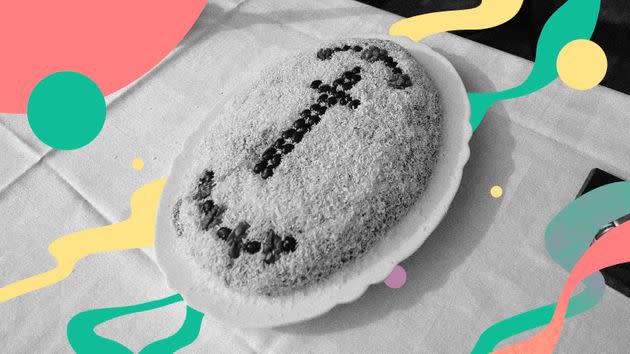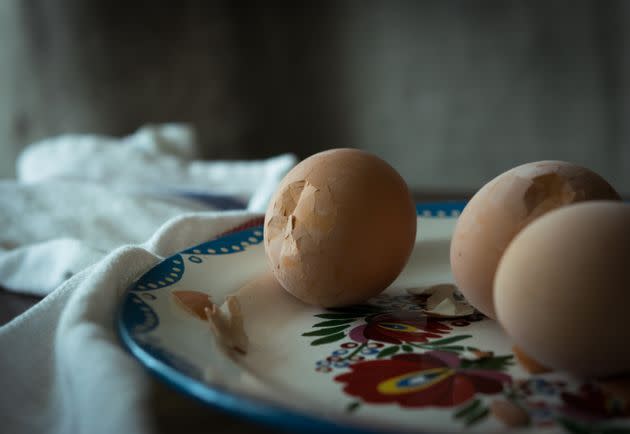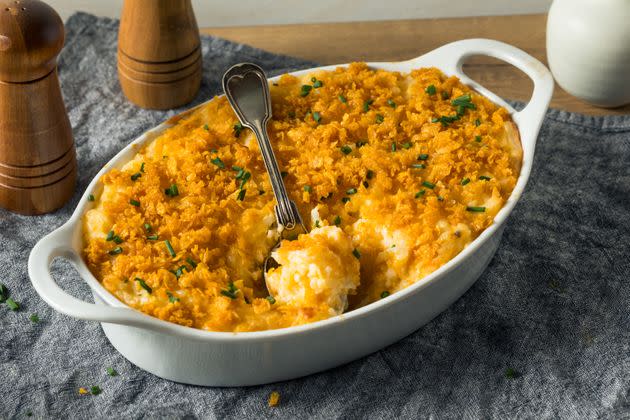Not Everyone Wants A Casserole: The Different Ways Cultures Grieve With Food

Orthodox Christian rituals in certain parts of Eastern Europe call for the consumption of koliva — a mix of seeds and grains shaped like a cake and sweetened with honey or sugar — after a blessing by a priest.
Mourning someone’s death is a deeply personal experience dependent on a variety of factors, including one’s own temperament, life experiences, cultural background, family traditions, mental health tendencies, religious beliefs and more.
There is, however, one aspect to grieving that seems to be a constant across regions and peoples: the role of food throughout the entire process.
As a general rule, comfort food plays a pivotal point during the days, months and even years following the death of a loved one. But the definition of comfort and, therefore, the type of fare that is being consumed throughout the mourning period, varies across traditions.
When my mother-in-law died, for example, my husband’s family subscribed to both Jewish and Mashadi customs during the mourning period, referencing both our religious ties and cultural ones to the city of Mashhad in Iran, where both of our ancestors are from.
As is customary in the Mashadi community, the children and siblings of the deceased were served a “seudat havra’a” as their first meal after the burial, one consisting of hard-boiled eggs that the mourners cannot peel or pay for themselves, but should be provided by friends or family and handed to them directly.
Rabbi Mosheh Aziz, co-author with Rabbi Avraham Ben-Haim of the book “Shenot Haim: Laws and Customs of Jewish Mourning,” explained, “It is customary for this meal to be simple and not a lavish [one].” The importance of simplicity carries through specifically Mashadi traditions as well, which call for memorial services on the eve of the seventh day, 30th day and 11th month since the burial.
Aziz explained that during each get-together, it’s customary to serve a modest meal in a non-extravagant fashion. Traditional foods that come from trees and the earth are usually preferable, including cucumbers, potatoes, grapes, eggs, raisins, roasted chickpeas, tea and Turkish coffee.

A “seudat havra’a” is the first meal after the burial in the Mashadi community, consisting of hard-boiled eggs that the mourners cannot peel or pay for themselves.
Some suggest that round foods like eggs represent the cycle of life. Overall, though, the culinary modesty that has come to define the mourning period within my personal traditions seems to have one prevailing meaning: A griever should focus on his grieving throughout the year after a close person’s death, without even using food as a distraction.
Interestingly enough, though, in Hong Kong, the customs call for what may seem to be the exact opposite of simplicity.
As explained by Canadian blogger La Carmina, who was born in Vancouver but whose family is from Hong Kong and considers itself Chinese, more lavish meals are de rigueur while mourning on that side of the world.
“When my grandfather passed, my grandma set up an altar in her house that consisted of incense and his favorite foods,” she explained. “Some of the most common foods are the most expensive ones like pork and barbecue duck because they are known as fancy foods that are people’s favorites.”
Post-funeral, it’s tradition to invite all family members over to the deceased’s home to have dinner together “as a way to let everyone have some closure,” she said. During the evening, sweets like candies are served to “take away the bitterness” that obviously comes with mourning.
In Chinese circles, there are also foods to stay away from right after the funeral, Carmina explained. Specifically, ones that “sound like negative words,” she revealed. “The word for melon, for example, is ‘guā,’ which sounds like the word for death, which is ‘sǐwáng.’ We try to avoid that when mourning because we don’t want negative energy or associations.”
But not all Asian traditions are the same, as chef Tojo Hidekazu, who was born in Japan and now lives in Canada, told me. He noted that it is customary for the close family of the deceased to not eat any sort of animal protein for 49 days after the passing, and his family follows suit ― even though they’re not necessarily religious. “We’re basically vegetarian for 49 days,” he explained. “Not even caviar or uni.”
Similar to Jewish tradition in terms of simplicity, many Japanese people will also stay away from garlic or any other strong spice because “we must be very sad,” he said.
That gastronomic blandness is particularly visible during a small ceremony that usually takes place a week after burial, during which “we serve food that doesn’t look fancy, it’s very sad and plain because we’re sad. It’s not colorful: it’s mostly green, brown and white,” the chef said.
Perhaps unsurprisingly given some similarities between it and Buddhism, many branches of Hinduism also call for the avoidance of meat for a set period of time after a death, a guideline that results in mourning menus filled with fruit and veggie dishes, especially within gift baskets that family and friends traditionally offer those in mourning.
Across other groups and denominations, gastronomic suggestions specifically relate to foods eaten during actual wakes and funerals.
Orthodox Christian rituals in certain parts of Eastern Europe, for example, call for the consumption of koliva — a mix of seeds and grains shaped like a cake and sweetened with honey or sugar — after a blessing by a priest.
Mormons, on the other hand, traditionally eat a dish of “funeral potatoes,” a casserole made with potatoes, onions, cheese, cream sauce, butter and topped with either corn flakes or potato chips, while Irish wakes are usually replete with traditional cakes made with cream cheese and dried fruits.

A homemade funeral potatoes casserole with cheese and chives.
Clearly, although the types of foods consumed and avoided throughout a mourning period change within cultures, families and traditions, the role of fare in general remains the same throughout: Our palates are to guide us through the proper way of mourning, whatever that may look like.
Some believe that, the less appetizing the food, the easier it will be to fully experience the sadness associated with death and avoid distractions — eventually allowing us to live through all stages of grief. Others find it more proper to celebrate a life that ended by consuming extravagant meals as a way to honor the deceased.
Whatever ritual you subscribe to — whether part of a larger religion or one originating within your own family — one thing is for sure: As humans, we rely on food for much more than mere sustenance.
